Having a steady supply of foliage is key to successfully making bouquets throughout the season—in spring, during the long months of summer, and into early fall. In this post, I’ll share the best staple foliages and foliage-like fillers, along with several of my favorite varieties.
Most of the varieties here can be grown from seed (the exceptions are ninebark, raspberry greens, and scented geranium). For more great fillers, like amaranth, cress, and millet, check out my post on Grasses, Grains, & Pods.
Scent is a bonus with many of these varieties. Some are culinary herbs with a magnetic fragrance (that might make you hungry), and others, like bells of Ireland and the eucalyptus varieties, have a fresh, clean scent. A few stems of any of these fragrant-leaved varieties will add perfume to your arrangements and bouquets.
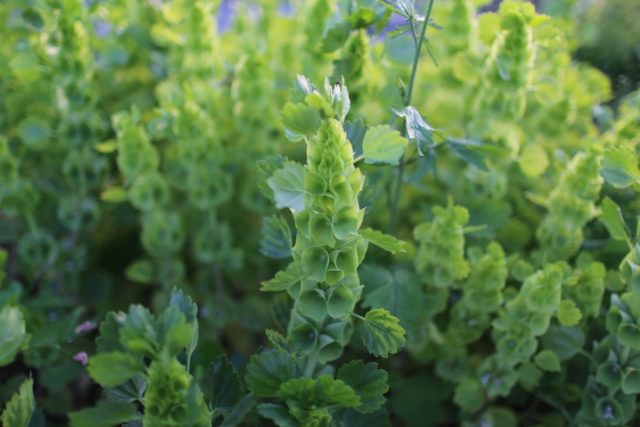 Spring
Spring
Bells of Ireland
Bells of Ireland (pictured above) is a cutting garden staple and one of the finest annual foliage plants you can grow for mixed bouquets. Plants are heavily branched, producing a bumper crop of tall, lime-green spires adorned with bell-shaped blooms. They have a lovely, subtle, springlike scent.
Harvest once the green bells start to form along the stem. Remove leaves from the lower half of the stem because they often yellow. Expect a vase life of 7 to 10 days with the use of floral preservative.
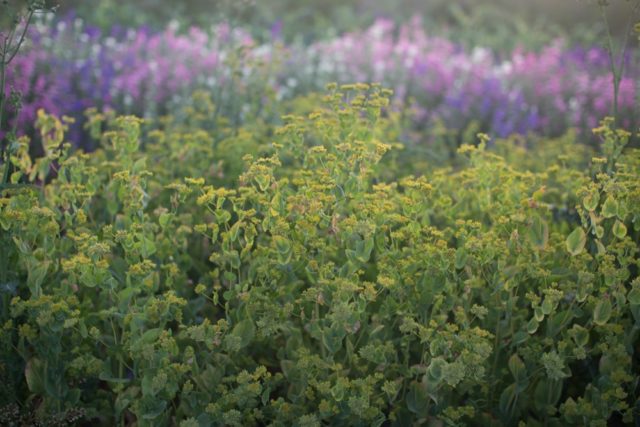 Bupleurum
Bupleurum
The bright, chartreuse-green blooms of bupleurum (pictured above) add sparkle and interest to early-summer arrangements. I love to combine the airy stems of this easy-to-grow flower with brilliant jewel tones or simple, clean whites and greens.
For an extended harvest, sow seeds every 2 to 3 weeks. In mild areas, seeds can be sown directly into the garden in fall. Everywhere else, direct-seed into the garden 6 weeks before the last frost.
Harvest when flowers are fully open; otherwise, they have a tendency to wilt. Fresh flowers last an incredibly long time in the vase, 8 to 10 days, with or without flower food.
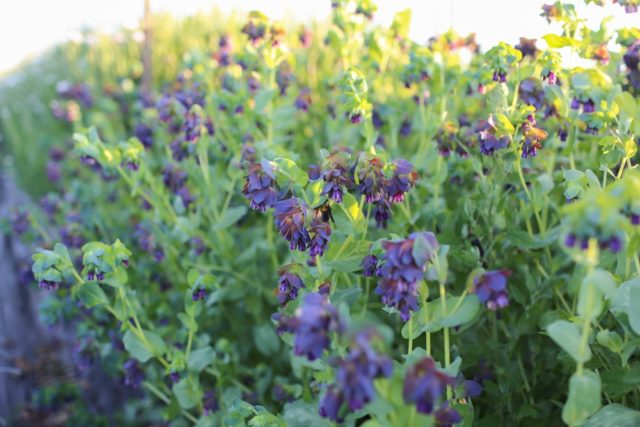 Honeywort
Honeywort
One of the most uniquely colored flowers I’ve ever grown, a single stem of honeywort (pictured above) in full bloom can be silver, blue, purple, and green all at the same time. Featuring gracefully arching stems with nodding blooms, these plants are easy to grow and produce a bumper crop for many weeks. Honeywort combines beautifully with most other flowers and makes a great bouquet filler. Bees love it.
Start seed indoors in trays 6 weeks before last frost; transplant out after all danger of frost has passed.
Harvest during the coolest hours of the day and treat stems right away by dipping the bottom 2 to 3 in (5 to 8 cm) in boiling water for 7 to 10 seconds and then placing them in cool water with preservative. Stems get very floppy immediately after harvest, but once hydrated, honeywort has a vase life of 7 to 10 days.
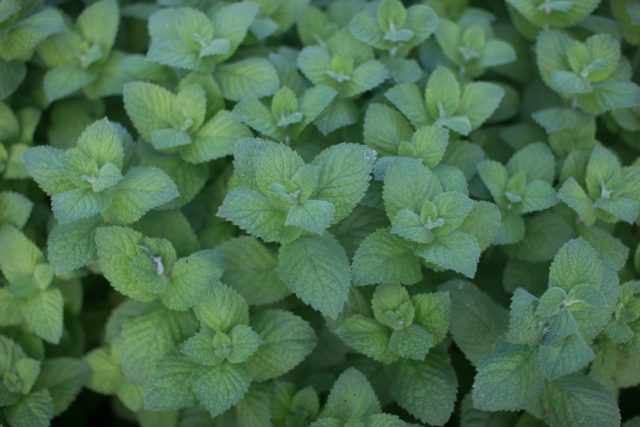 Mint
Mint
I was advised to never plant this vigorous spreader but am so glad I didn’t listen. Mint is one of the first foliage plants available to harvest in the spring and makes early-spring bouquets possible.
My two favorite varieties are of the same species, Mentha suaveolens: apple mint and its variegated sister, pineapple mint. They have a fruity fragrance and slightly fuzzy leaves that are larger than those of other mints. Apple mint (pictured above) is a beautiful medium green, while the pineapple ‘Variegata’ is green and creamy white. They are hardy to zone 5 and can grow up to 2 ft (60 cm).
You can start plants from seed in either spring (in cold climates) or autumn, when varieties are available in nurseries. Plant in full sun to part shade, in a place where they can wander without causing any trouble. If you don’t want your mint to spread, tuck plants into large pots or a whiskey barrel planter.
Pick stems when they’re mature and have become firm and they’ll last for well over a week, sometimes even rooting in the vase. No floral preservative is needed.
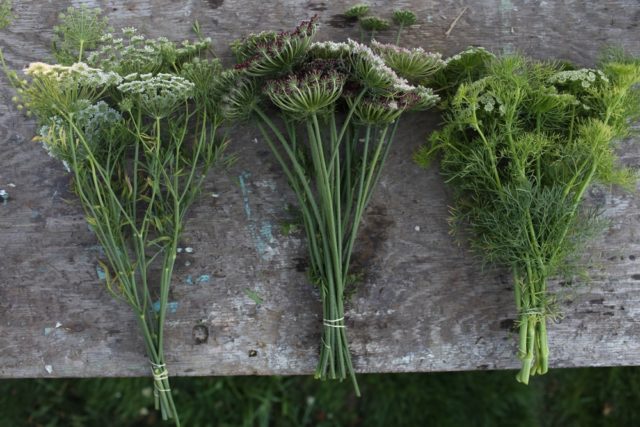 Queen Anne’s lace
Queen Anne’s lace
This beautiful hardy annual—actually a false Queen Anne’s lace—is one of the most productive and versatile filler plants you can grow from seed. The lacy flower heads and crisp green-and-white color mix well with everything and provide an invaluable backbone for late-spring and early-summer bouquets. I plant hundreds of them each year and use every single stem.
Plants get large, so space them 12 to 18 in (30 to 46 cm) apart, and be sure to stake them early so they don’t topple over in heavy spring rains. For staking, I recommend using flower netting attached to sturdy posts, since these plants are quite bulky. To extend the harvest, succession-sow every 2 weeks.
‘Green Mist’ (pictured above, right) produces tall plants, 36 to 48 in (1 to 1.2 m), with an abundance of wide, umbel-shaped blooms over a long period of time. ‘Queen of Africa’ (pictured above, left) is a gorgeous, very tall variety, 48 to 65 in (1.2 to 1.7 m), with more-open flower heads.
Cut when about 80 percent of the flowers on a stem are open. If harvested much earlier, the stems have a tendency to wilt. Fresh flowers will last 6 to 8 days in the vase with flower preservative.
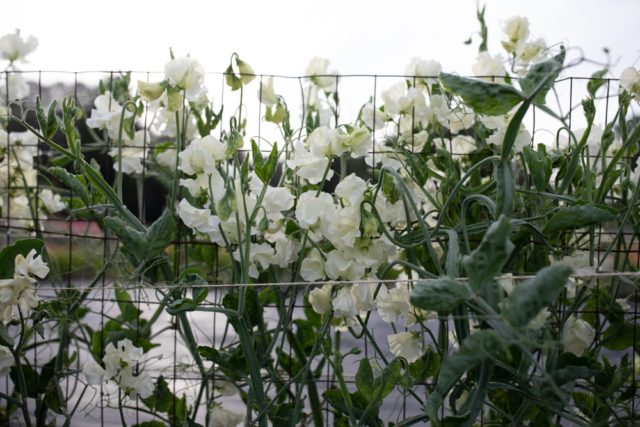 Sweet pea vines
Sweet pea vines
Sweet peas (pictured above) were the flowers that inspired me to begin my flower journey, and they are a favorite at our farm. We offer more varieties of sweet pea than any other plant, several developed by renowned breeder Keith Hammett of New Zealand. Be sure to check out this blog post on my favorite sweet pea varieties.
While sweet peas are beloved for their gorgeous, fragrant blooms, they also are a surprisingly wonderful filler. The wild-looking vines add amazing texture, shape, and volume to arrangements. We typically get a vase life of 4 to 5 days from the foliage and tendrils.
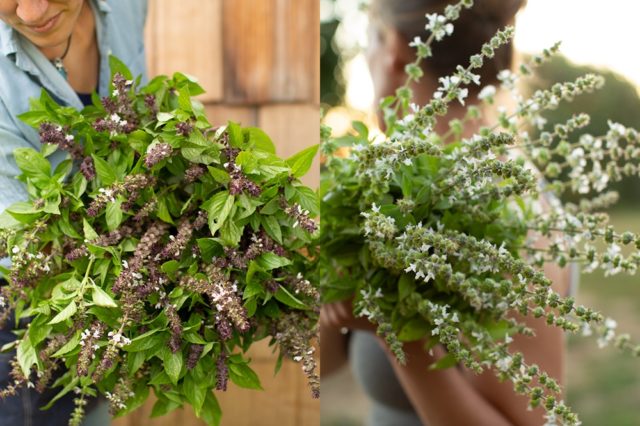 Early to midsummer
Early to midsummer
Basil
With a spicy, licorice-like scent, basil is one of the most fragrant, easy-to-grow, and abundant summer foliage plants. Plants are easy to start from seed, but they should be protected from cool weather in the spring, so don’t set them outside until all danger of frost has passed. (In our cool climate, basil must be grown in low tunnels to lessen disease pressure and extend the stem length).
‘Cinnamon’ (pictured above, left) is a lovely variety featuring dark purple flowers atop green leaves and chocolate-colored stems.
‘Mrs. Burns Lemon’ (pictured above, right) fills a room with its clean, citrusy scent. The bright green foliage and white flowers are fragrant, and we combine them with zinnias for a fast, beautiful bouquet from midsummer through autumn.
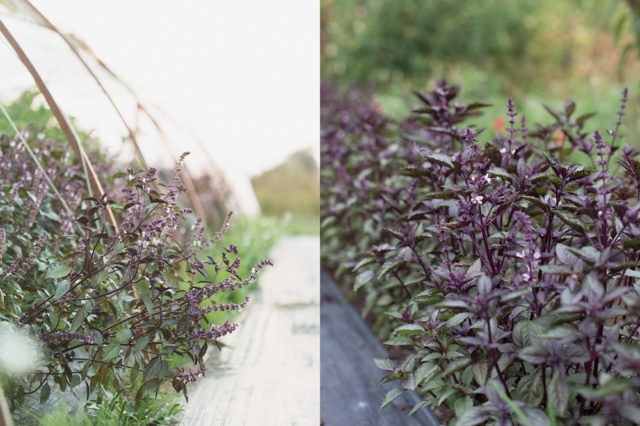 ‘Aromatto’ (pictured above) is a handsome variety that features tall, deep purple stems, glossy bicolor plum-veined leaves, and brilliant amethyst flower spikes. The aromatic foliage is a spicy combination of licorice and mint.
‘Aromatto’ (pictured above) is a handsome variety that features tall, deep purple stems, glossy bicolor plum-veined leaves, and brilliant amethyst flower spikes. The aromatic foliage is a spicy combination of licorice and mint.
Once cut, basil foliage is prone to wilting in the heat, so harvest when it’s cool, morning or evening, and let stems rest in water for a few hours before using them. Expect a vase life of 7 to 10 days; stems often root in the vase. No floral preservative is needed.
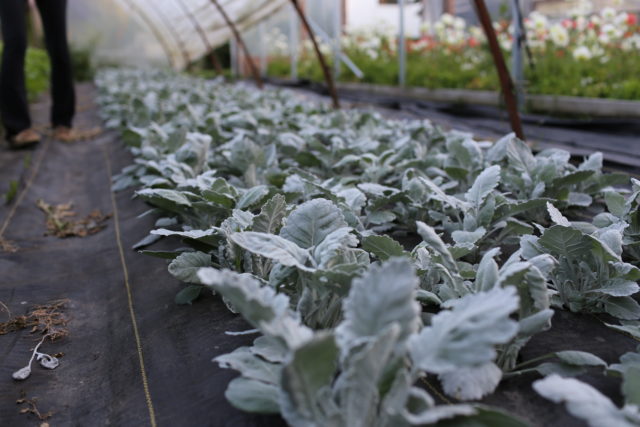 Dusty miller
Dusty miller
The variety ‘New Look’ (pictured above) is one of the most productive and unique foliage plants around. This special dusty miller features tall, thick stems with large, smooth-edged silver leaves. The more you pick it, the more stems it produces. Ready to cut just 4 months from sowing, this hardworking plant will reward you with buckets of fuzzy, silvery foliage all season long. In warmer areas it will perennialize if mulched.
Start seed indoors in trays 10 to 12 weeks before last frost; transplant out after all danger of frost has passed. Seed is slow to start; bottom-watering is recommended until plants emerge. Seedlings do not look silver when very young but color up as they mature.
Cut foliage is prone to wilting in the heat, so harvest during the coolest part of the day and place immediately in water to rest for a few hours before arranging. Stems will last 7 to 10 days in the vase.
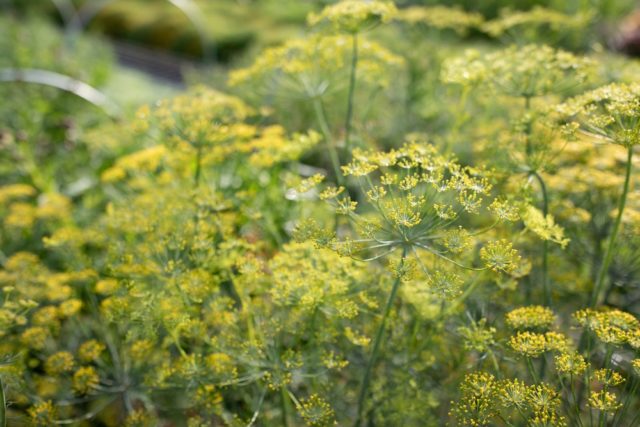 Dill
Dill
‘Bouquet’ (pictured above) is an early-maturing variety that produces tall stems loaded with large, chartreuse umbels. This plant is extremely versatile and makes a wonderful addition to summer bouquets. It’s beautiful when stems have just set seeds, and everyone loves dill’s nostalgic scent.
Start seed indoors in trays 4 weeks before last frost, then gently transplant out after all danger of frost has passed. Dill can also be direct-seeded into the garden after your last frost date. Provide support so stems don’t topple. For an extended harvest, sow 2 to 3 successions.
Harvest when umbels are fully open and bright yellow-green, and remove some of the ferny foliage near the base of the stem. Expect a vase life of 7 to 10 days.
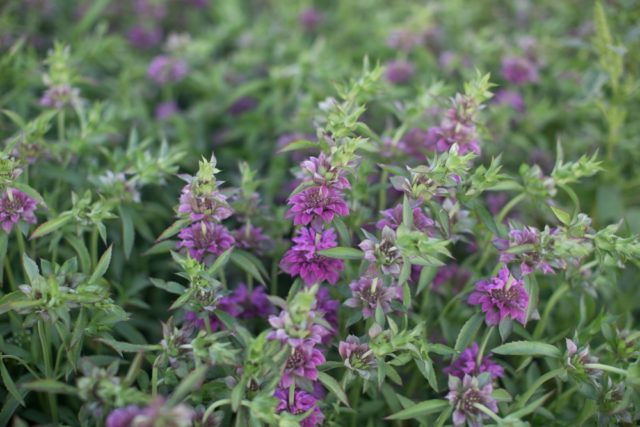 Bee balm (Monarda)
Bee balm (Monarda)
While all kinds of Monarda are very productive, the annual variety ‘Lambada’ (pictured above) is even more notable than the perennials. The plant is easy to grow from seed in spring, has foliage that smells like Earl Grey tea, and holds well in arrangements. Its unusual overall coloring—a mix of green, gray, and soft purple—and the whorl-shaped blooms make it more useful as a filler plant, like bells of Ireland, than as an actual flower.
It can be succession-planted throughout the summer, and it churns out an enormous volume from even the smallest planting.
Cut when the flower whorls begin to turn from all green to purple. These flowers are prone to wilting in the heat, so harvest in the cool of the morning or evening and place in water to rest for a few hours before arranging. Stems will last 7 to 10 days if you use floral preservative.
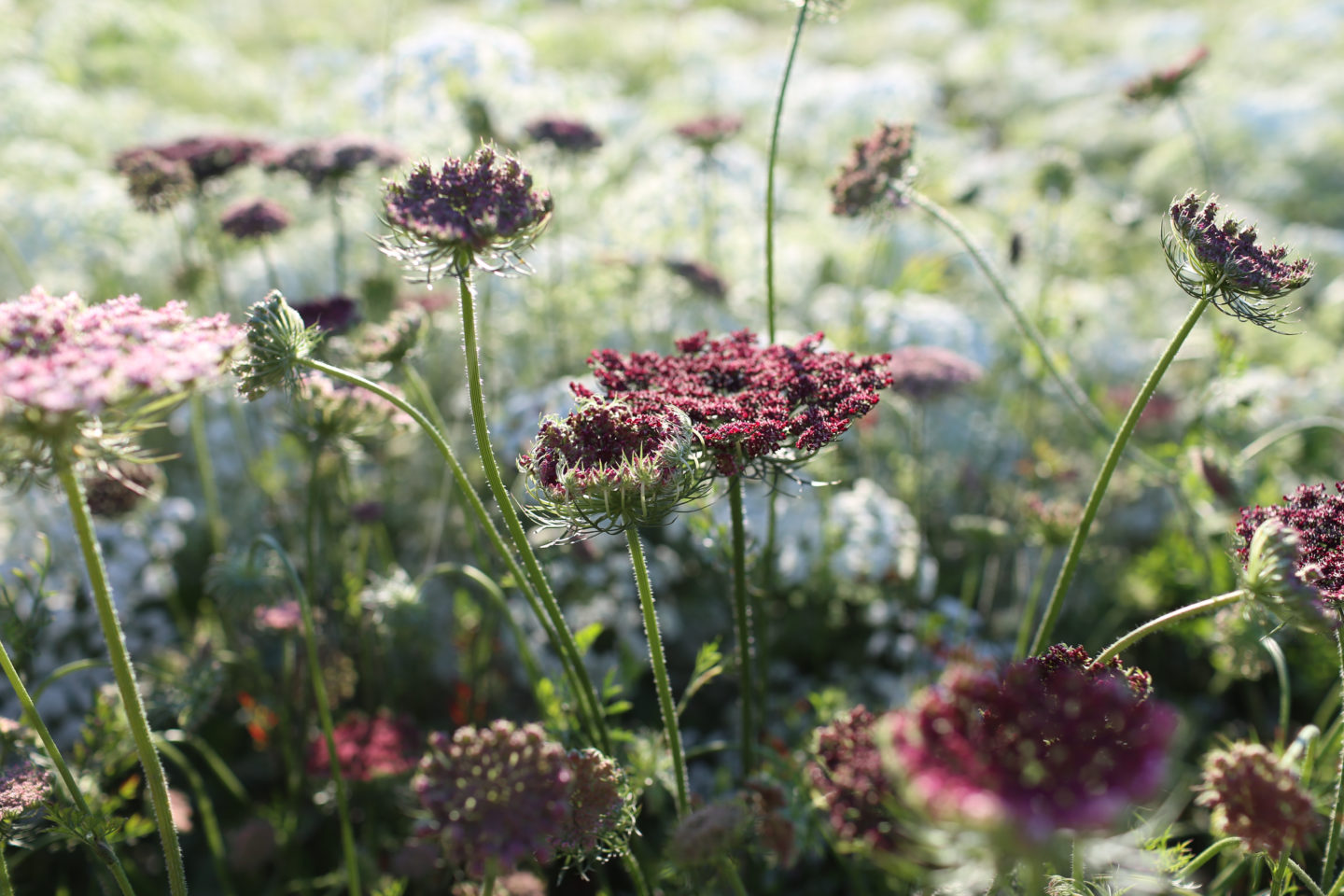 Chocolate lace flower
Chocolate lace flower
The variety ‘Dara’ (pictured above), a large-flowered, burgundy-chocolate-colored Queen Anne’s lace, has been an absolute hit at our farm from day one. It looks great en masse, pairs well with almost anything, and blooms for most of the summer from just one planting. The lacy umbels come in a range of sizes and shades, adding a dramatic, airy quality to finished arrangements.
Space plantings and stake just as you would Queen Anne’s lace. Cut when flowers have fully opened and flower heads are flattened across the top. Expect a vase life of 6 to 8 days with floral preservative.
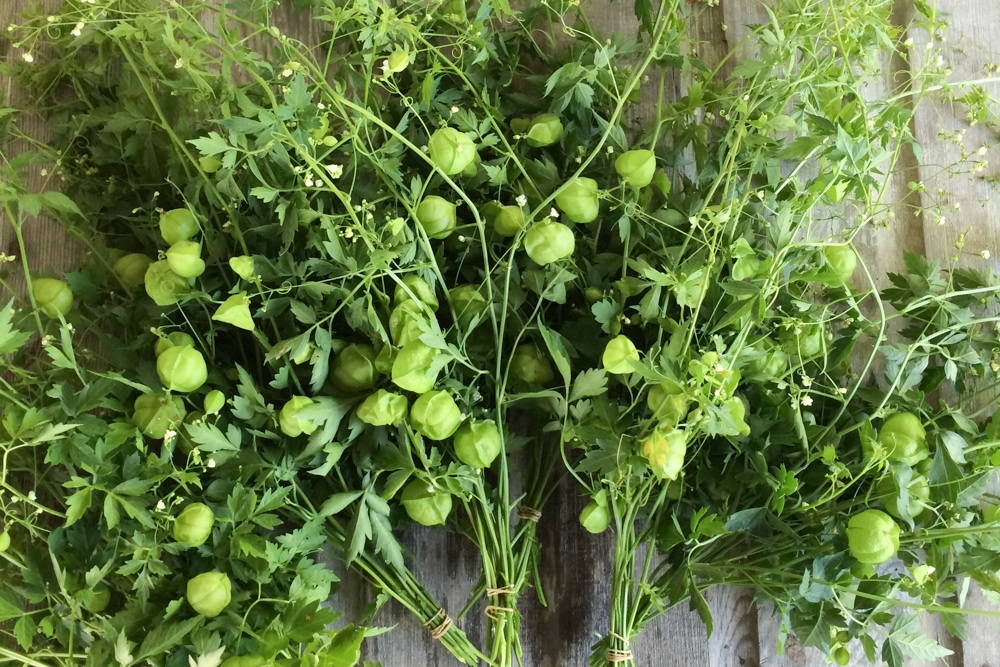 Love-in-a-puff vine
Love-in-a-puff vine
The long, ferny-leaved vines of love-in-a-puff (pictured above) are loaded with tiny white blossoms, and the intriguing green, balloon-like pods resemble miniature paper lanterns. What is even more magical is that inside each balloon are tiny black seeds imprinted with perfect white hearts. These vigorous growers will scramble up and over a trellis in no time. Woven into an arrangement, this beauty will take any creation to a whole new level.
Start seed indoors in pots 8 to 10 weeks before last frost; transplant out after all danger of frost has passed. Love-in-a-puff is very sensitive to cold; wait until the weather has warmed to plant out. Provide a strong trellis or support for vines to climb.
Choose stems that have firmed up and are covered in little green lanterns. Cut foliage is prone to wilting in the heat, so harvest during the coolest part of the day and place immediately in water to rest for a few hours before arranging. Stems will last a good week in the vase if flower preservative is used.
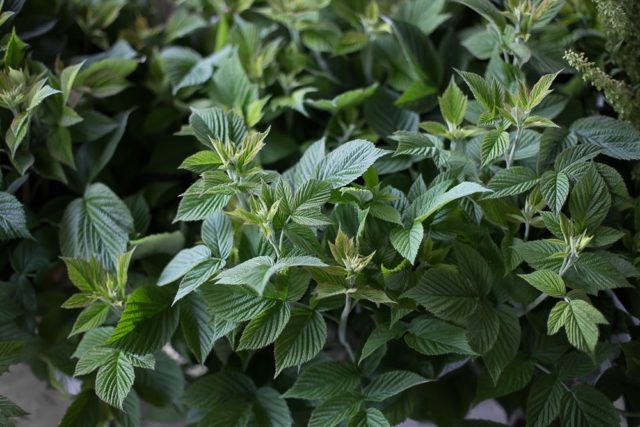 Raspberry greens
Raspberry greens
I started using this wonderful foliage in bouquets years ago, and it is still on my top favorite list of things we grow. The greens (pictured above) last up to 2 weeks in the vase and are wildly productive, providing foliage all season long.
The everbearing varieties (‘Summit’ and ‘Golden’) are best for an extended harvest of fruiting stems, can be cut to the ground in the winter for easy cleanup, and spread rapidly for increased stock. They grow in poorer soil than traditional summer-fruiting types, and they fruit in yellow and red. I also love the variety ‘Tulameen’ and get my bare-root stock from Burnt Ridge Nursery here in Washington State.
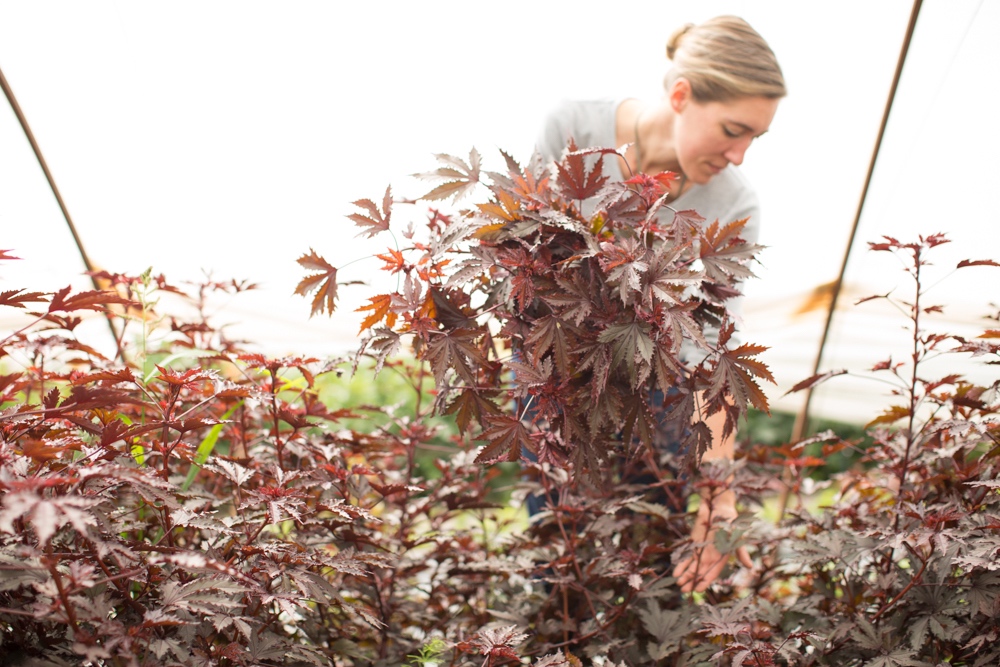 Red-leaf hibiscus
Red-leaf hibiscus
With dramatic deep burgundy foliage that resembles Japanese maple leaves, the variety ‘Mahogany Splendor’ (pictured above) provides great height to garden borders and adds drama to large container plantings. Grown primarily for its striking, serrated foliage, hibiscus only flowers indoors in temperate regions. The more you cut this heat- and drought-tolerant plant, the more it produces.
Start seed indoors in 4-in (10-cm) pots 4 to 6 weeks before last frost; transplant out after all danger of frost has passed.
Harvest during the coolest part of the day once the foliage is mature and leathery and the tips are no longer floppy. Strip leaves from the lower half of the stem and sear stem ends in boiling water for 5 to 7 seconds. Expect a vase life of 7 days.
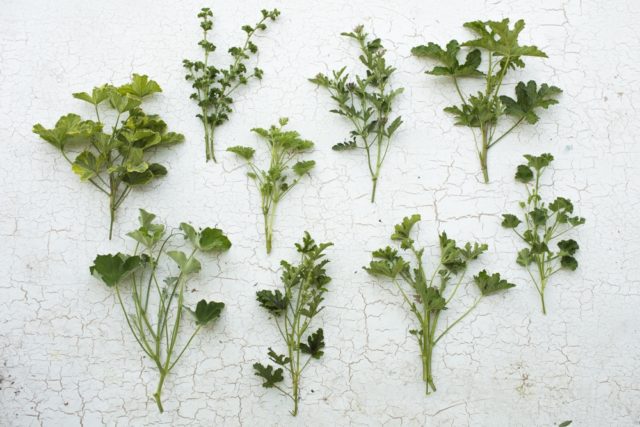
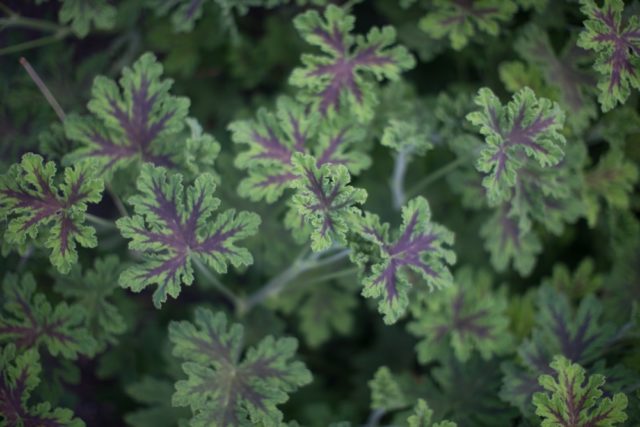 Scented geranium
Scented geranium
This foliage makes an amazing base for arrangements from midsummer to late autumn. The variety ‘Chocolate Mint’ (pictured above) is worthy of special mention; with large leaves splashed with burgundy veins, it is hands down my favorite. I also adore ‘Attar of Roses’. The smells are just as the names indicate. You can order plants from Select Seeds.
Start from plants in spring, after all danger of frost has passed. If left to grow, stems can reach 3 ft (1 m), making them perfect for large bouquets. Space all plants 1 ft (30 cm) apart in full sun. I grow mine under a low tunnel—the added heat encourages lush, vigorous growth and allows me to plant them earlier in the season and keep harvesting up until the first hard frost.
For best results, it’s essential to delay cutting until plants have matured enough to harden up a bit. Cut early in the morning or in the cool of the evening, then immediately place stems in water and let them rest in a cool spot for a few hours. These stems will often last more than a week in the vase with floral preservative.
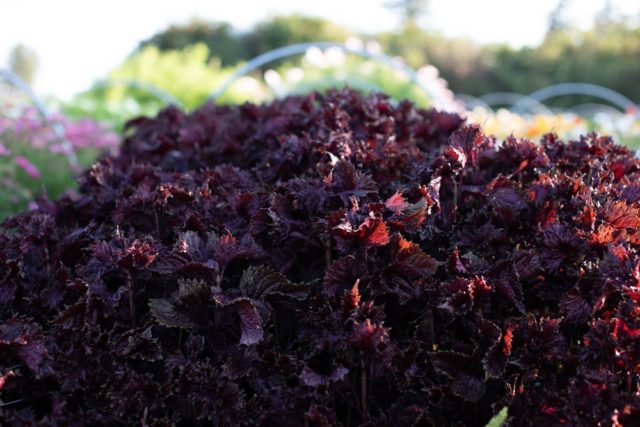 Shiso/Perilla frutescens
Shiso/Perilla frutescens
This culinary herb also happens to be a productive, long-lasting foliage coveted by designers. There are several beautiful varieties, including ‘Britton’, which has rich green leaves with deep red undersides.
Our favorite is ‘Purple Frills’ (pictured above), which has striking, deep chocolaty-maroon foliage and provides exceptional textural interest in arrangements. Leaves are crimped and curled, with serrated edges. Flowers are nondescript, and this variety is a superb, scented dark foliage choice from midsummer through autumn.
Perilla is easy to grow, and if you give it ample room, you’ll be rewarded with 15 to 20 stems per plant. Be sure to let it get nice and ripe before picking, or it will wilt; it’s similar to basil in that regard. Harvest when the foliage has become thick and the stems are woody, or any time after a flower spike begins to emerge. If you pick it too young, dip stem ends in boiling water for 15 to 20 seconds, and it will perk back up. I’ve had stems last 2 weeks in the vase.
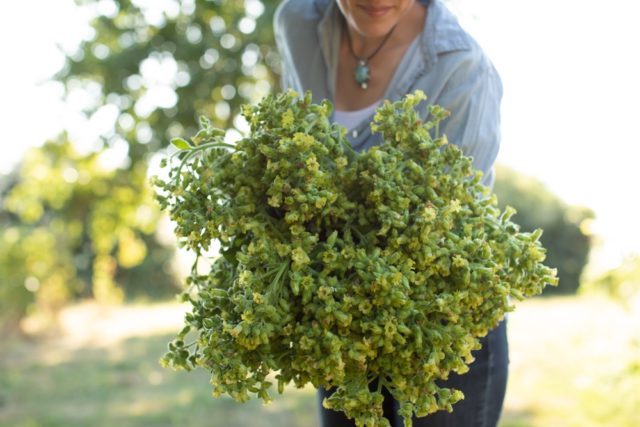 Flowering tobacco
Flowering tobacco
There are a number of varieties grown for cutting, and one of my favorites is ‘Rustica’ (pictured above). This broad-leaved plant is quite unassuming until it shoots up thick stems loaded with acid-green, bell-shaped blooms. The versatile color works with nearly every palette, and the tall stems are a perfect filler for large-scale arrangements.
Blossoms are well-loved by pollinators and are fragile, so take care when harvesting. Remove spent flowers from the lower half of the stem every few days. Expect a vase life of 7 days.
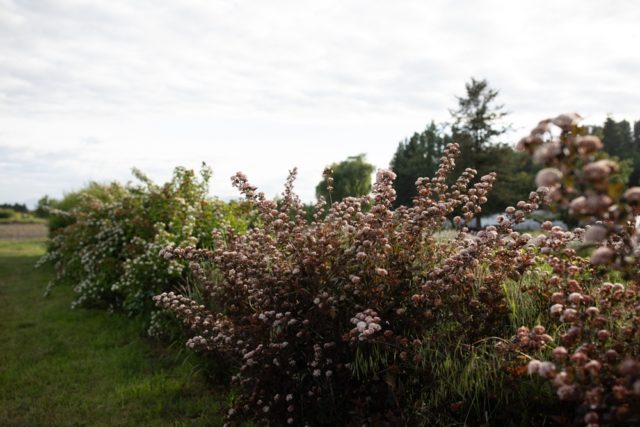 Ninebark
Ninebark
Ninebark (pictured above) is one of the most productive and hardworking shrubs you can grow for cutting. Beginning in late spring, plants produce flower-loaded stems that are ideal in arrangements. Once the flowers fade, they leave behind small clusters of gorgeous seedcases that provide a textural accent to design work.
Throughout the rest of the season, this shrub just keeps pumping out foliage-laden stems. What makes it so special is that it comes in a number of unusual colors rarely found in the plant world.
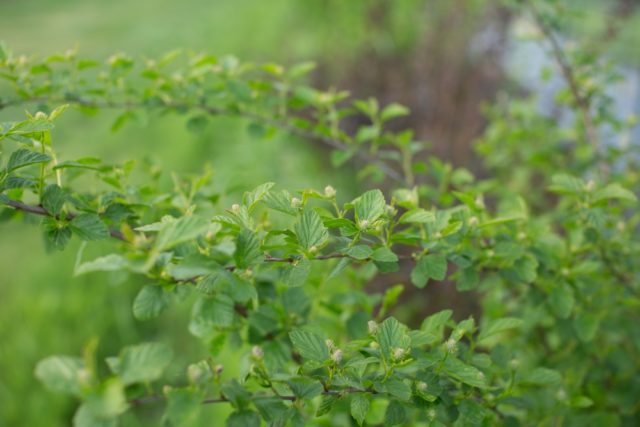 I love the green-leaved common ninebark, Physocarpus opulifolius (pictured above), native throughout the eastern U.S. My favorite hybrid varieties are ‘Coppertina’, with brownish burgundy-orange leaves, ‘Summer Wine’, with dark wine-colored leaves, and ‘Diabolo’, which has nearly black foliage. Stems have a 10- to 14-day vase life if cut when the leaves are fully mature.
I love the green-leaved common ninebark, Physocarpus opulifolius (pictured above), native throughout the eastern U.S. My favorite hybrid varieties are ‘Coppertina’, with brownish burgundy-orange leaves, ‘Summer Wine’, with dark wine-colored leaves, and ‘Diabolo’, which has nearly black foliage. Stems have a 10- to 14-day vase life if cut when the leaves are fully mature.
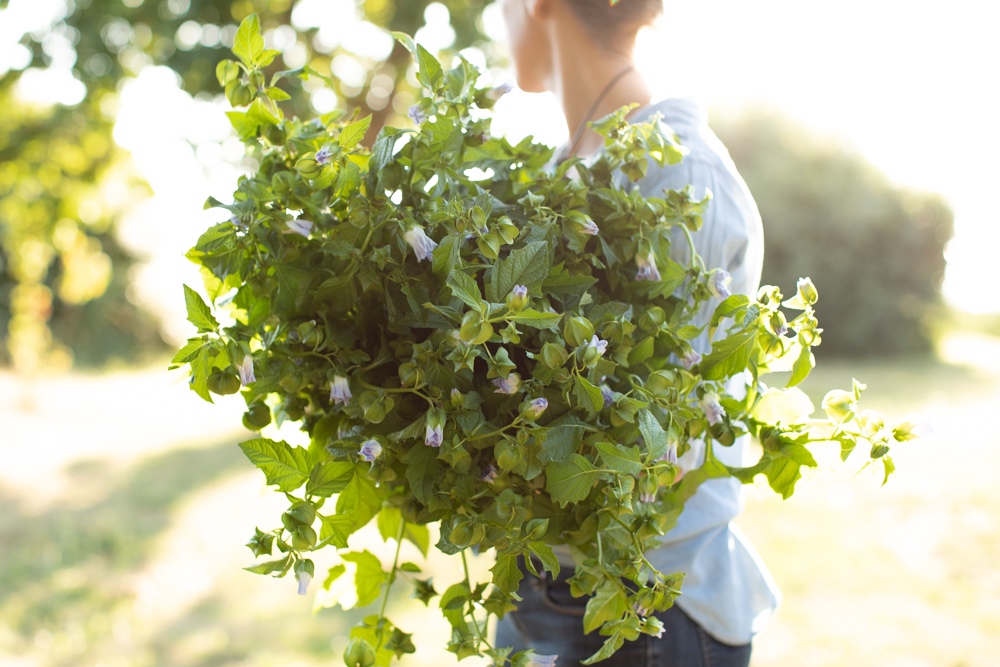 Late summer
Late summer
Apple of Peru
The foliage of apple of Peru (pictured above), a soaring, easy-to-grow plant, is one of our most hardworking fillers on the farm. Stems are loaded with glowing green lanterns that appear after their periwinkle blossoms drop, and the plant resembles a giant tomatillo with blue flowers. A great addition to the landscape, each plant produces buckets of bouquet material from midsummer to autumn.
Start seed indoors in trays 4 to 6 weeks before last frost; transplant out after all danger of frost has passed. Harvest once seedpods have formed, and remove the foliage so that the lanterns are more visible. Expect a vase life of 7 days.
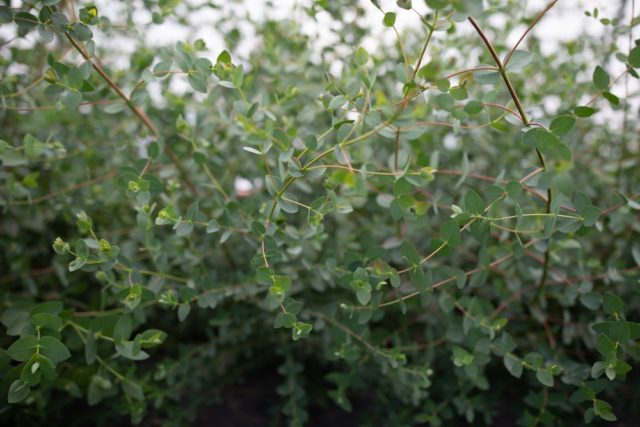 Eucalyptus
Eucalyptus
Eucalyptus (pictured above) is a staple, much in demand by florists and for weddings. Its blue-green and silvery hues set off both cool and warm floral palettes, and everyone seems to love its distinctive menthol fragrance. And it’s doubly useful because it can be dried and used indefinitely; it’s a favorite in autumn wreaths.
Though it is actually a tree, eucalyptus can be grown as an annual from seed if started early indoors. Sow seed on the surface of the soil and do not cover. Seeds are very slow to germinate and can take 45 days to sprout, so be patient.
Cut fresh, eucalyptus is a long-lasting foliage—often 2 weeks in the vase. Harvest once foliage is mature and tips are no longer droopy.
Here are some of my favorite varieties.
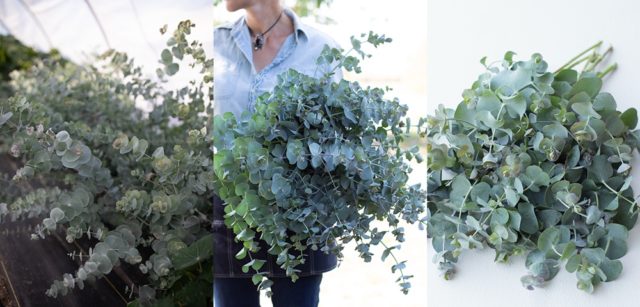 ‘Round-leaved Mallee’ (pictured above) is a strongly scented variety with gray-green foliage that bends and arches, sending off whirling side branches. It makes an excellent bouquet filler when foliage has fully ripened. Of all of the eucalyptus we grow, this is our favorite.
‘Round-leaved Mallee’ (pictured above) is a strongly scented variety with gray-green foliage that bends and arches, sending off whirling side branches. It makes an excellent bouquet filler when foliage has fully ripened. Of all of the eucalyptus we grow, this is our favorite.
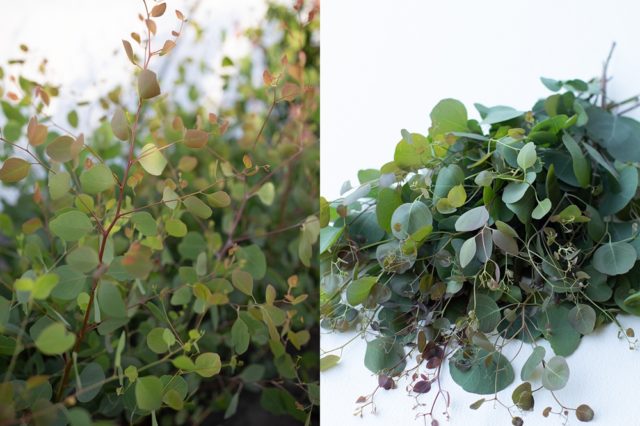 ‘Silver Dollar’ (pictured above) has ginkgo-shaped leaves that alternate up striking purple-red stems. New growth has a beautiful bronze cast. Each branching plant produces loads of stems that are perfect for flower arranging.
‘Silver Dollar’ (pictured above) has ginkgo-shaped leaves that alternate up striking purple-red stems. New growth has a beautiful bronze cast. Each branching plant produces loads of stems that are perfect for flower arranging.
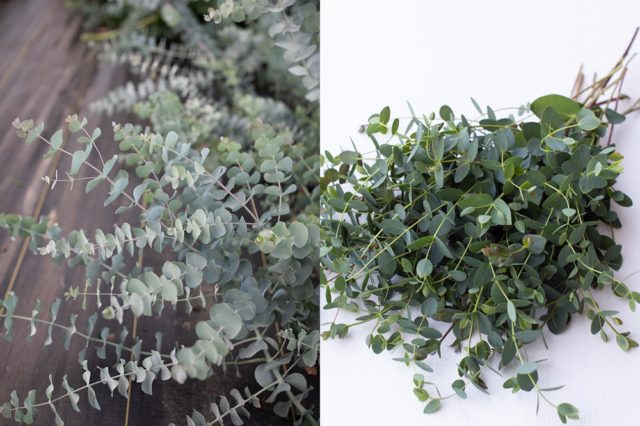 ‘Small-leaved Gum’ (pictured above) has wispy cranberry stems covered in airy sage-green foliage with a clean, menthol scent. This extremely versatile variety makes a wonderful bouquet addition.
‘Small-leaved Gum’ (pictured above) has wispy cranberry stems covered in airy sage-green foliage with a clean, menthol scent. This extremely versatile variety makes a wonderful bouquet addition.
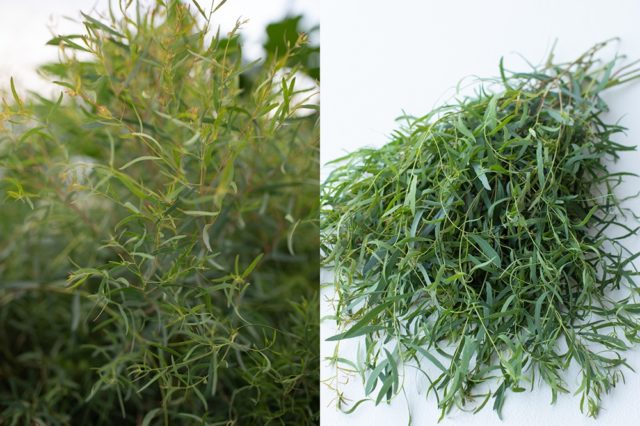 ‘Nichol’s Willow’ (pictured above) has striking cranberry-red stems offset by beautiful willow-like blue-green foliage. Delicate, narrow leaves are perfect for event work and are a flower arranger’s dream.
‘Nichol’s Willow’ (pictured above) has striking cranberry-red stems offset by beautiful willow-like blue-green foliage. Delicate, narrow leaves are perfect for event work and are a flower arranger’s dream.
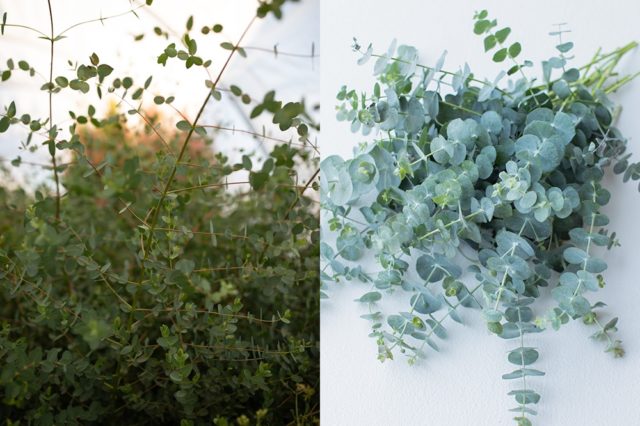 ‘Baby Blue’ (pictured above) is a beautiful plant producing large sprays of blue-gray stems covered in distinctly rounded leaves that alternate from side to side. This variety is a fragrant and textural addition to late-season bouquets.
‘Baby Blue’ (pictured above) is a beautiful plant producing large sprays of blue-gray stems covered in distinctly rounded leaves that alternate from side to side. This variety is a fragrant and textural addition to late-season bouquets.
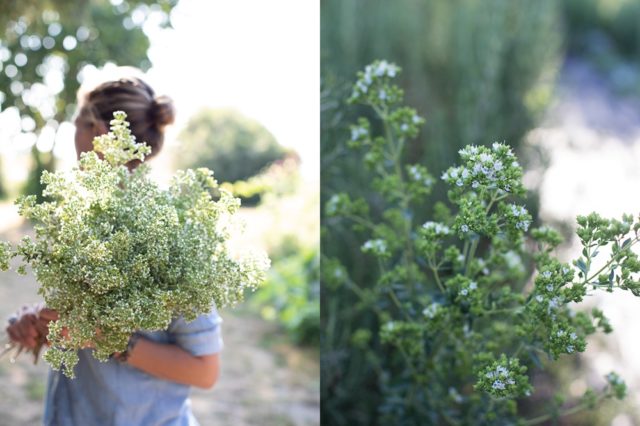 Oregano
Oregano
Oregano is one of the most hardworking and useful perennial filler plants we grow. It thrives in heat, and its fragrance alone is reason enough to grow it, but so is the beautiful, edible foliage, as well as the full flower heads that quickly fill out a bouquet. The fluffy seed heads left behind are an amazing addition to any arrangement. Cut at either stage and expect a vase life of 7 to 10 days.
Pollinators love oregano!
Greek oregano (pictured above), the gorgeous classic species, has glowing green stems topped with fragrant, airy white blossoms. The flowers leave behind seed heads that complement summer flowers perfectly. It’s a must-grow for market bouquets.
You can grow Greek oregano from seed, and if you sow seeds early enough, plants will flower the first year. Start seed indoors in trays 8 to 10 weeks before last frost. Seed requires light to germinate, so do not cover. Bottom-water until seedlings emerge. Transplant out after all danger of frost has passed.
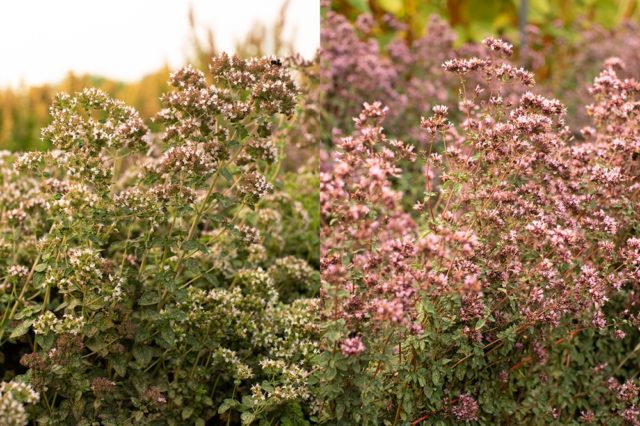 Two other favorites of mine must be grown from plants. ‘Hopley’s Purple’ (pictured above, left) grows to about 2 ft (60 cm) and produces flower heads full of reddish-purple blooms; ‘Herrenhausen’ (above right) is a Royal Horticultural Society Award of Garden Merit winner with cerise-pink flowers. These are really special varieties I rely on.
Two other favorites of mine must be grown from plants. ‘Hopley’s Purple’ (pictured above, left) grows to about 2 ft (60 cm) and produces flower heads full of reddish-purple blooms; ‘Herrenhausen’ (above right) is a Royal Horticultural Society Award of Garden Merit winner with cerise-pink flowers. These are really special varieties I rely on.
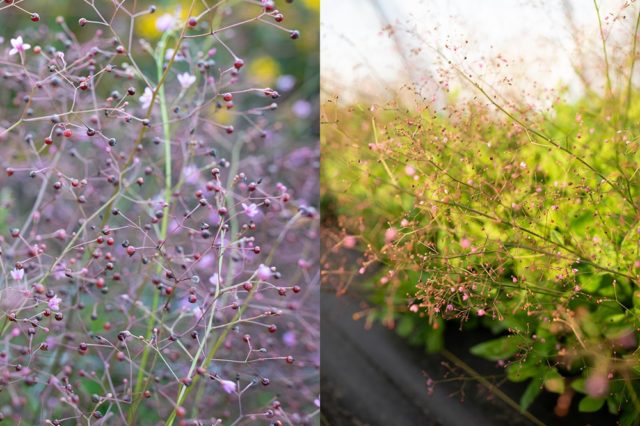
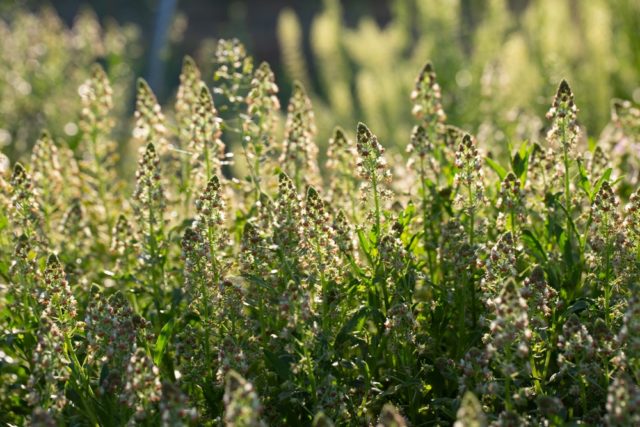 In addition to eucalyptus and any foliage still going strong in early autumn, you can also use many grasses, pods, and seed heads. Jewels of Opar (pictured above, top) and ‘Garden Mignonette’ (above) are two of my favorite varieties (see my post on Grasses, Grains, & Pods).
In addition to eucalyptus and any foliage still going strong in early autumn, you can also use many grasses, pods, and seed heads. Jewels of Opar (pictured above, top) and ‘Garden Mignonette’ (above) are two of my favorite varieties (see my post on Grasses, Grains, & Pods).
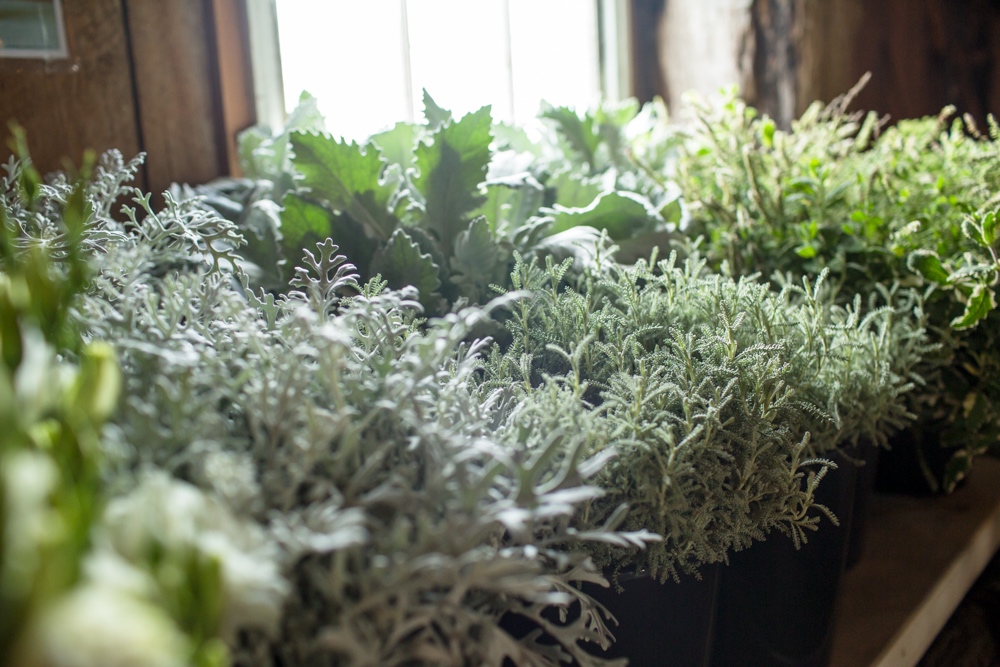 I would love to hear your experience with foliage and fillers. Do you grow them or plan to add them to your garden this coming season? If so, what are your favorite varieties?
I would love to hear your experience with foliage and fillers. Do you grow them or plan to add them to your garden this coming season? If so, what are your favorite varieties?
Please note: If your comment doesn’t show up right away, sit tight; we have a spam filter that requires us to approve comments before they are published.

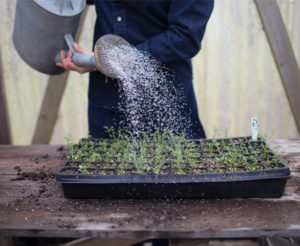
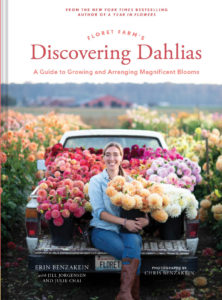
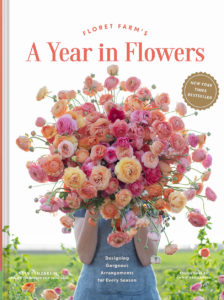
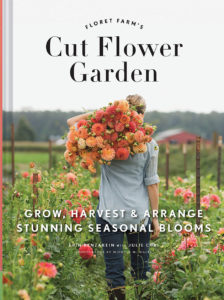

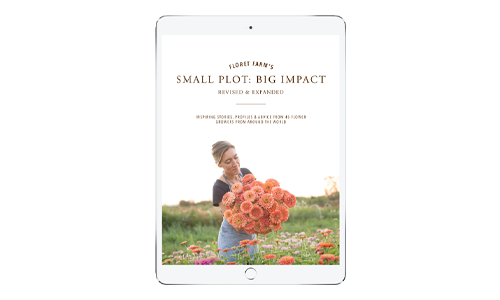
Elizabeth on
Hi, thank you for all the amazing resources! I’m having trouble finding a source for Nichols Willow/Peppermint Willow seeds. Can you point me to a specific seller for this? Thanks, Elizabeth in Boston, MA